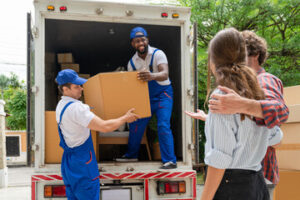Movers in Spring Texas have become more than carriers of belongings from one place to another. They now shape experiences by blending physical service with technology and personalization. What was once just lifting and transporting has grown into a more dynamic and thoughtful practice. Their role today reflects the changing demands of people and businesses alike.

One new shift is the rise of eco-friendly moving strategies. Instead of relying only on traditional packing, movers are exploring materials that can be reused or composted. These adjustments reduce environmental strain while keeping items safe in transit. It shows a deliberate move toward sustainability in even the smallest details.
Technology has also reshaped how movers function. Real-time tracking lets clients monitor their belongings as they travel. This transparency builds trust and reduces the anxiety that often comes with moving. The sense of control it gives to clients is a breakthrough in service.
Personalization has become another growing trend. Movers now tailor packages based on lifestyle, needs, and timelines. A family moving long distances may receive different solutions than a student relocating locally. This flexibility makes the experience more practical and human-centered.
Remote coordination is also rising in importance. Digital platforms allow customers to manage bookings, payments, and schedules without face-to-face interaction. This streamlines communication and avoids misunderstandings. It also reflects how digital systems now weave into everyday services.
One of the new ideas shaping the industry is smart packing. Movers are adopting organized systems that label, scan, and catalog items before transport. This ensures nothing is lost and items can be easily traced when unpacking. Smart packing reduces stress for both movers and clients.
Health and wellness are also influencing moving services. Workers are trained not only in lifting techniques but also in ergonomics to prevent strain. Clients benefit because teams perform efficiently and with fewer delays caused by injuries. This awareness brings a more professional and sustainable approach to the job.
Another new concept is micro-moving. Instead of large-scale moves, clients sometimes need smaller, highly specific relocations. Movers have adapted by offering compact services that handle only a few items with the same precision as full-scale moves. It fills a gap that traditional movers once overlooked.
Community-based moving support is also emerging. Instead of working in isolation, movers now partner with local networks for storage, supplies, or temporary services. This creates stronger ties and ensures smoother experiences. It reflects how moving is becoming less about one team and more about connected systems.
Technology-driven safety is another growing aspect. Sensors on trucks now track temperature, movement, and vibration to protect fragile items. Clients transporting sensitive belongings such as instruments or electronics can feel secure. This shows how innovation goes beyond logistics into care and preservation.
Emotional support has quietly entered the moving space. For many people, moving is not just physical but also sentimental. Movers who understand this offer more patience and communication during stressful transitions. This emotional awareness reshapes the image of movers as supportive partners rather than just labor.
Flexibility in timing has become an essential trend. Movers now adapt to late-night, weekend, or even phased moving schedules. This allows clients to settle into new spaces gradually rather than all at once. It gives people more control over their pace of transition.
The global shift toward smaller living spaces has also influenced movers. Teams now specialize in navigating tight hallways, staircases, and compact elevators. They design strategies to minimize risk while working within constraints. This adaptation highlights the creativity required in modern moving.
Hybrid moving solutions are another new development. They combine professional help with do-it-yourself options for clients who want partial involvement. Clients may pack some items while movers handle transportation and heavy lifting. This partnership gives people a sense of balance and control.
Digital documentation has also transformed the moving process. Photos, checklists, and signed forms are stored online for clarity. This reduces disputes and ensures accountability for both sides. It also keeps processes cleaner and more transparent.
Another important advancement is the use of renewable energy in transport. Some movers now experiment with trucks powered by alternative fuel sources. This reduces emissions while maintaining efficiency. It pushes the industry toward greener operations.
Inclusive moving services are also expanding. Movers now design solutions for clients with unique needs, such as seniors or people with disabilities. This includes extra assistance, specialized equipment, and clear communication. Such inclusivity broadens the scope of what movers can offer.
Education and training continue to elevate standards. Movers today are skilled not only in handling objects but also in customer service, safety, and technology. This makes their work more professional and adaptable. It raises expectations for the entire industry.
Even storage solutions have grown alongside moving. Temporary or flexible storage options now accompany many services. This helps clients manage delays, renovations, or staged relocations. Storage and moving have become integrated rather than separate.
Drones and automation are starting to influence the field too. Drones help survey paths, check access points, and even deliver small items. Automation speeds up loading and inventory processes. These innovations make moving faster and more precise.
Another trend is the growing role of movers in global transitions. People are relocating across borders more often, and movers adapt with knowledge of customs, rules, and logistics. They simplify what once felt overwhelming. This global awareness shows how their role has broadened.
Movers are also tapping into predictive data. Algorithms can now forecast the best routes, times, and strategies for each project. This prevents unnecessary delays and reduces costs. Predictive planning enhances efficiency while easing stress.
The industry is also more mindful of mental wellbeing during relocations. Some movers connect clients to resources that help with adjusting to new spaces. This added dimension recognizes that moving is a life event, not just a service. It deepens the value movers bring.
These new developments reshape movers into more than carriers. They are now organizers, problem solvers, and partners in life transitions. By blending technology, empathy, and efficiency, movers are creating a new identity in their work. Their future lies in continuing to refine the art of moving into a more seamless journey.
As movers evolve, the image of the industry shifts with them. They are no longer seen as only physical workers but as guides in relocation. They balance sustainability, innovation, and human care in every step. Their role in shaping how people start anew cannot be understated.
Through these innovations, movers demonstrate that progress is possible even in traditional services. Each advancement adds depth to their identity and strengthens the trust people place in them. They are proving that moving is not just about boxes and trucks but about shaping journeys with purpose.




